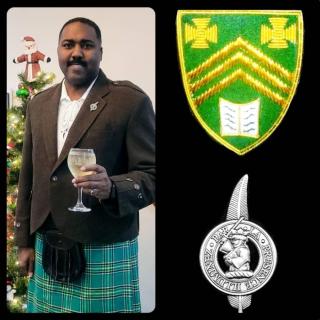


Baha-
Bahá'u'lláh is the last in a series of great beings previously associated exclusively with particular religions, including Hinduism, Judaism, Zoroastrianism, Buddhism, Christianity, Islam, and many others. (Most Holy Book), completed 1873; goal is to unify all religious practices. Bahá'ís must take to heart one of three obligatory prayers each day. Bahá'ís respect the infallible authority of the Universal House of Justice, with an elected board of nine governs at its base in Haifa, Israel. Bahá'ís must take to heart one of three obligatory prayers each day. Choices such as drinking alcohol or the attribute of homosexuality, are specifically prohibited by a legacy of Bahá'í tradition in an effort to promote true righteousness over immediate or temporary worldly unity. Bahá'í Faith promotes secular studies and promises doctrinal conformation with the discoveries of worldly authorities. Bahá'í Faith encourages studies in physical sciences; if appropriate, quickly assimilated into Bahá'í ideology.
Buddhism-
Noble Truths, are: Suffering exist, Suffering has a cause, namely, desire. Desire is the only cause of suffering. There is a way to end desire. One need only accept these statements to be a Buddhist. An elaboration on the fourth Noble Truth is the below Eightfold Path, which is a series
of steps for Buddhist adherents to follow in order; Right views, Right intention, Right speech, Right conduct, Right livelihood, Right strivings, Right mindset, and Right concentration. If one uses the Eightfold Path to attempt to achieve the fourth Noble Truth, then one uses Buddhist tradition. “Buddha” comes from a Sanskrit word meaning “enlightened,” “knowing,” or “awake.” In Buddhism it is used as a title for anyone who has achieved enlightenment.
Siddhartha Gautama, a prince born around 560 BCE in the northern part of the Indian subcontinent; pursued the end to suffering; when he achieved this end, he taught the path he learned as the Buddha. Buddhism as a faith tradition does not necessarily incorporate teachings about spirituality; however, various cultures often apply their own understandings about spirituality to Buddhism. Those who have achieved nirvana are free from samsara, or the cycle of death and rebirth.
Cao Dai-
(Dai Dao Tam Ky Pho Do)- Originated in South Vietnam in 1926. Dai Dao Tam Ky Pho Do translates into 'Great Religion of the Third Period of
Revelation and Salvation' and adherents believe that the sect was created directly by God through his communication with its first four disciples. Cao Dai means 'Kingdom of Heaven' and the religion's ultimate goal is to free the believer from the repetitive cycle of birth and death. Goal:
unite competing religious beliefs and assist people in joining God the Father in Heaven. Today Cao Dai has between 2.5million and 8million adherents in Vietnam, with a further 30,000 living in Australia, the USA and Europe. The religion is anti-confrontational and does not involve itself in the politics of the countries in which its followers live. In summary, Caodaiists follow paths of nonviolence, prayer, the veneration of ancestors and vegetarianism so as to reach their goals of uniting with God and being released from the birth/death cycle. Caodaiists also believe in gender equality, although women are not permitted to join the two highest Caodaiist religious ranks, and worship both God the Father as well as the Mother Buddha.
Catholicism-
With more than a billion members, the Roman Catholic Church, or more commonly, the Catholic Church, is the oldest and largest Christian denomination in the world today. Ignatius of Antioch is the first person known to have referred to the "Catholic Church." It appears in his Letter to the Smyrnaeans, written around 107 AD. The Catholic Church teaches that there are three sources of authority: the Scripture, Sacred Tradition, and the Church's interpretation of the first two; Doctrine- Catechism of the Catholic Church. Catholics & Protestants have major differences regarding authority, salvation, and faith. It is believed and taught in Catholicism that Christ himself instituted seven sacraments. The Sacraments are: Baptism, Confirmation, the Eucharist, Reconciliation, Anointing of the Sick, Holy Orders, and Holy Matrimony. The Virgin Mary holds a distinctive position in Catholicism, and Catholics offer her devotions and prayers. The Assumption of Mary is the belief that Mary was assumed bodily into heaven at her death. These teachings are not to be found in the Bible. The Pope and his cardinals are held as the successors to Peter and the Apostles. The Council of Rome, held in 382, established the Biblical canon. Eventually, the early Church came to be organized under the three patriarchs of Rome, Alexandria and Antioch. The year 431 saw the first large rupture, or schism, occur in the Church. The Council of Ephesus, held that year, stated that because the humanity and divinity of Jesus are inseparable, his mother Mary was necessarily the Mother of God. She was given the title Theotokos, which means God-bearer. Those who refused to accept the Council's ruling are represented today by the Assyrian Church of the East. The next major break was after the Council of Chalcedon, held in 451. This Council declared that Christ was one person with two natures. The Church in Alexandria rejected the teachings of this Council, and today these Churches are referred to as Oriental Orthodox Churches. The 11th century saw the next major division in Catholicism, when the East-West Schism occurred. Differences in doctrine, church government, and worship practices that had developed over the centuries lead to a split in the year 1054 that divided the Church between East and West. Most of Western Europe was in the Western camp, while Greece, Romania, Russia, Syria, Turkey, and Egypt made up the Eastern camp. The greatest division in the Church occurred in the 16th century with the Protestant Reformation. At this time many not only rejected the structure of the Catholic Church, but many of its teachings. This last division would prove to be the most devastating, and the most permanent. Today, slightly less than half of the world's Christian population is a member of the Roman Catholic Church.